The Role of Bird Toys in Parrot Happiness and Health
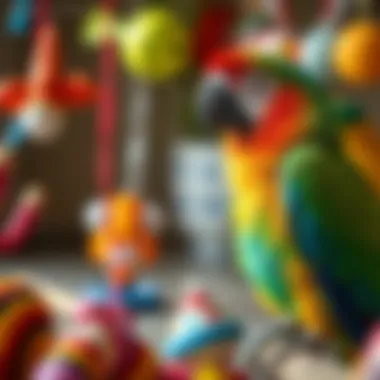
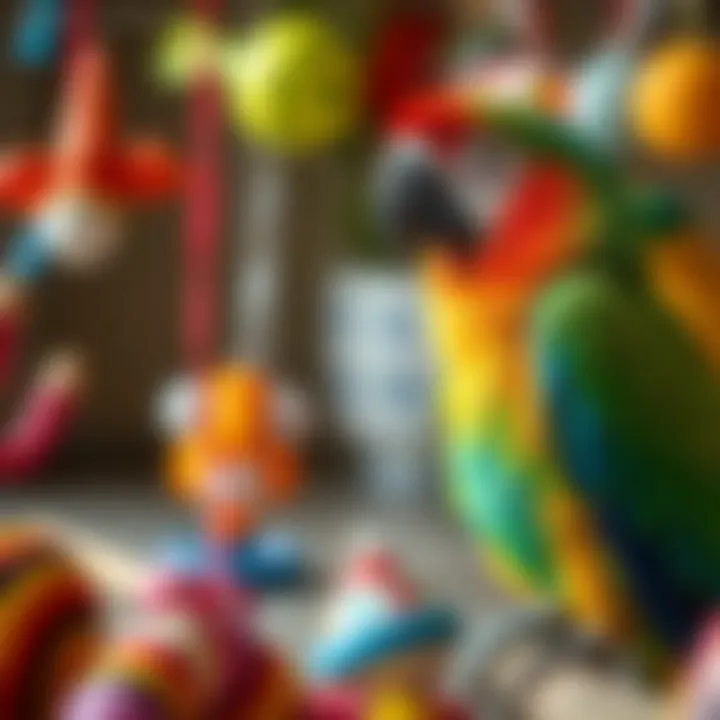
Intro
Choosing the right toys for your parrot isn't just about keeping it busy; it's crucial for their well-being. Engaging toys can stimulate a parrot's mind and body, offering benefits that run much deeper than mere entertainment. This article seeks to provide an in-depth look at how appropriate toys play an essential role in fostering a happy, healthy environment for our feathered friends.
Understanding the nuances of parrot behavior, the types of toys available, and how they can impact your pet's health are key components that we will explore in detail. From mental stimulation to physical exercise, the right bird toys can make all the difference in ensuring that your parrot thrives, both mentally and physically.
Understanding Your Pet
Pet Behavior Basics
Parrots are incredibly intelligent creatures known for their playful behavior. They are not just pets; they are social beings. Understanding their natural instincts helps us choose toys that cater to their needs. In the wild, parrots spend a lot of time climbing, chewing, and exploring. Mimicking these behaviors at home can significantly enhance their quality of life. For instance, a parrot that climbs will likely appreciate toys that facilitate this instinct, such as ropes and ladders.
Common Breed Characteristics
Different parrot breeds exhibit distinct characteristics that can influence toy choice. African Greys are known for their curious nature and love for problem-solving; hence, puzzle toys work wonders for them. Cockatoos, on the other hand, may prefer destructible toys that allow them to chew. Understanding these traits is vital in choosing toys that will keep them engaged. Parrots, if provided with the right toys, will often show increased activity levels, improved verbal skills, and a healthier outlook.
Species-Specific Needs
Each species of parrot has unique requirements. For example, larger parrots like Macaws may need sturdier toys that can withstand their strong beaks, whereas smaller species such as Budgerigars might not require such durable options. It's essential to match the toy's size and material to your bird's specific needs to ensure safety and enjoyment. This approach not only keeps your parrot active but also reduces the chances of boredom, which can lead to behavioral issues.
Enrichment and Activities
When it comes to keeping your parrot content and vibrant, enrichment activities are paramount. These activities can be classified into various types, which can either be indoor or outdoor.
Indoor vs. Outdoor Activities
While indoor play is vital for daily exercise, outdoor activities can elevate your parrot's experience to new heights. If your living environment permits, letting them bask in natural sunlight provides essential vitamin D, while also lowering stress levels. However, caution is key; always supervise your parrots outdoors to prevent unexpected mishaps, such as predators or escape attempts.
Interactive Toys and Games
Engaging your parrot with interactive toys can significantly stimulate their cognitive abilities. Toys that require them to solve problems, such as treat-dispensing puzzles, are particularly beneficial. Not only do these toys keep them busy, but they also teach essential skills. Incorporating activities like hide-and-seek with toys or teaching them to retrieve items can add variety to their routine.
Socialization Opportunities
Socializing your parrot is another critical component of enrichment. Whether it’s through interaction with you, family members, or even other birds, social activities offer mental challenges. Group play sessions using toys can improve their communication skills and reduce anxiety. Birds enjoy engaging with their environment, so incorporating elements that allow them to play alongside you or others can foster a more satisfying life.
Engaging toys serve not merely as entertainment. They are vital instruments in enriching the lives of parrots, enhancing both mental and physical health.
In summary, understanding your pet is the stepping stone towards providing a fulfilling life for your parrot. Selecting toys that align with their natural behaviors, preferences, and species characteristics adds another layer of joy and satisfaction. Research has shown that enriched and engaging environments can lead to better mental health in birds, giving our feathered companions a chance to thrive. As we move further into this article, we’ll delve into selecting the right toys and addressing safety considerations that any conscientious pet owner should keep in mind.
Intro to Parrots
Parrots are not just vibrant, feathered companions; they are incredibly intelligent creatures with unique behavioral needs. Understanding parrots is crucial for anyone considering keeping one as a pet or already nurturing a feathered friend in their home. This section lays the groundwork for delving into the intricate relationship between parrots and their toys, shedding light on how these seemingly simple objects can greatly impact their quality of life.
Understanding Parrot Behavior
To appreciate the role of toys in a parrot's life, one must first grasp their complex nature. Parrots, like humans, can exhibit a range of emotions and behaviors. They can be curious, playful, and even moody, much like a toddler who just woke up from a nap. Their intelligence is often compared to that of a five-year-old child, meaning they require mental stimulation and social interaction. In the wild, these birds engage in various activities, such as exploring their environment, foraging for food, and playing with one another.
For a parrot, boredom can lead to behavioral issues such as feather plucking or aggressive tendencies. Recognizing patterns in their behavior—like the difference between happy squawking and distressed screeching—allows owners to respond effectively. A parrot displaying repetitive motions, like swinging back and forth, could likely benefit from a stimulating toy or interaction. By tuning into these behaviors, you can foster a positive atmosphere that reflects their natural instincts.
The Importance of Enrichment
Engagement is not merely an option; it’s a necessity for parrots. Enrichment goes beyond providing food and water; it encompasses a wide variety of activities, knowledge, and tools to stimulate a parrot’s mind and body. Bird toys serve as essential instruments in this enrichment process. Just as a child thrives when engaged in creative play, parrots also flourish in an environment filled with stimulating toys.
Here are some ways enrichment impacts parrots:
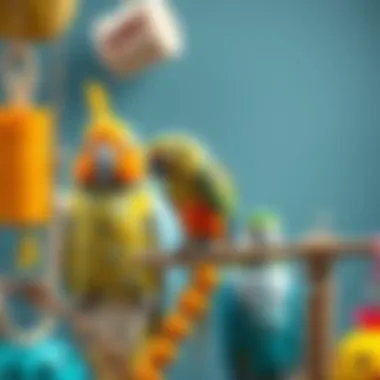
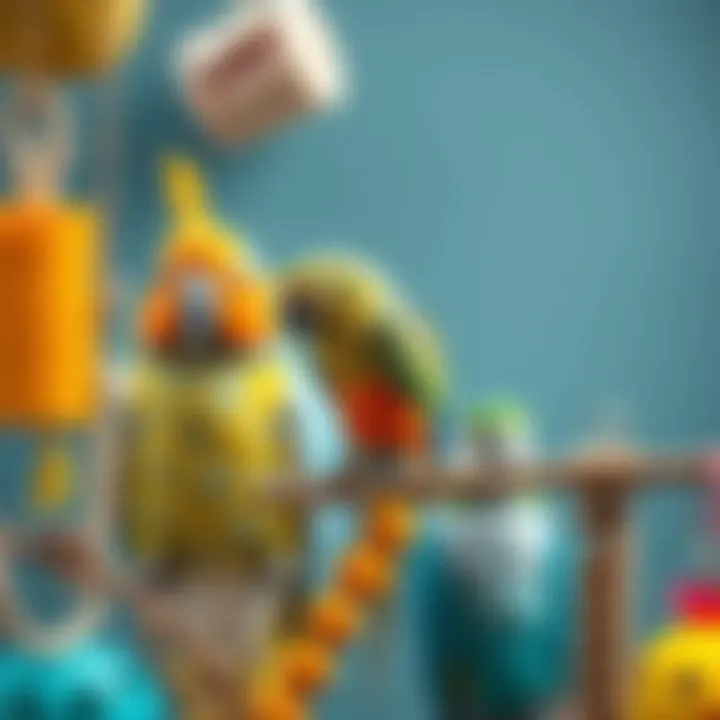
- Mental Stimulation: Toys that challenge a parrot’s problem-solving skills keep their minds sharp and engaged. Puzzle toys, for example, require parrots to figure out how to access a treat, mimicking foraging behaviors in the wild.
- Physical Activity: Many toys encourage movement; climbing and swinging are natural behaviors that can keep parrots physically fit. This is especially important in a domestic setting, as it helps prevent obesity, a common issue among caged birds.
- Social Interaction: Interactive toys promote bonding opportunities between the owner and their bird. Playing together can strengthen the relationship, making the parrot feel more secure and loved.
Ultimately, neglecting the enrichment needs of a parrot can lead to deeper behavioral issues or health problems. Prioritizing these factors lays a foundation for a happy, healthy companion who thrives in a stimulating environment.
"Creating an engaging space for your parrot is not just about filling their cage with toys. It's about understanding their needs, preferences, and behaviors."
By recognizing the richness of parrot behavior and the significant role of enrichment, we prepare to explore how specific toys contribute meaningfully to their well-being.
The Nature of Joy in Birds
Understanding what brings joy to our feathered friends is essential for their health and happiness. Parrots, like humans, experience emotions, and a joyful parrot is often a sign of good mental and physical well-being. Toys play an instrumental role in this equation, enabling parrots to engage, explore, and express their natural instincts. By recognizing what makes these remarkable birds happy, owners can better meet their needs, transforming their living space into a sanctuary of happiness. The focus on joy in birds fosters awareness of their emotional landscape and the significance of enrichment.
Recognizing Signs of Happiness
Capturing the essence of a happy parrot often starts with keen observation. Parrots express their joy in various ways that are quite telling.
- Vocalization: Happy parrots are typically raucous. They chatter, whistle, and even mimic sounds from their environment. If your feathered friend is singing their heart out, they're likely feeling quite content.
- Physical Play: Engaging with toys, swinging from perches, and climbing are fantastic indicators of a cheerful parrot. When they get into a playful mood, they may also display acrobatics that indicate that they are feeling playful and spirited.
- Body Language: Relaxed posture, fluffed feathers, and a bright-eyed demeanor signify that a parrot is content. If they are comfortable with you around, they might also conveniently perch close by as a sign of trust.
It's crucial to note that these signs sometimes vary among individual parrots. Each parrot possesses its personality, and recognizing unique behaviors constitutes a vital part of understanding their happiness.
"A joyful bird not only brightens the day; it offers a glimpse into the vibrant world of emotional intelligence in animals."
Long-Term Effects of Happiness
The ripple effects of happiness in parrots can be expansive, reaching far beyond fleeting moments of joy. A parrot that regularly experiences happiness often leads a more fulfilling and longer life. Numerous studies indicate that birds exposed to enriching environments exhibit signs of lower stress and reduced aggression. Parrots with a strong emotional constitution—from engaging toys to keen owner interactions—are less likely to develop destructive behaviors, which in turn promotes better relationships with their human companions.
- Healthier Habits: A happy parrot is likely to eat better, as a content bird is more willing to experiment with different foods and to stay active, exploring their surroundings.
- Less Stress-Related Illness: When birds are engaged and happy, they are less prone to stress-related illnesses and behavioral problems. An enriched environment serves as a buffer against anxiety, keeping both the birds and their owners in harmony.
- Social Bonding: Happy parrots are also more inclined to form strong bonds, both with other birds and humans. This connection enhances the bird's overall quality of life, fostering a sense of security and affection.
In summary, the relationship between happiness and the health of a parrot is complex yet captivating. As pet owners, it’s our responsibility to cultivate environments where our feathered companions can thrive emotionally and physically, by paying close attention to their signs of happiness and the long-term effects it can have.
Types of Bird Toys
In the realm of parrot care, the choice of bird toys is not just a matter of preference but a fundamental component in fostering a healthy and stimulating environment for these intelligent creatures. Each type of toy serves a unique purpose, catering to various aspects of a parrot's physical and mental wellbeing. Understanding these types can enhance your pet’s life more than you may think, as they play a pivotal role in alleviating boredom, promoting exercise, and encouraging natural behaviors.
Chew Toys: Benefits and Uses
Chew toys are often the first toys that come to mind for many parrot owners, and it’s no wonder why. These toys fulfill an innate need for parrots to chew, which is crucial for their beak health and overall comfort. By providing enjoyable chewing options, you allow your feathered friend to satisfy their instinctual behaviors. Furthermore, toys made of natural materials like wood, rope, or bamboo tend to be safer and more engaging.
With chew toys, monitoring wear and tear is essential. If a toy starts to splinter or fall apart, it’s time to swap it out for a fresh one. This keeps the environment safe while providing endless entertainment.
Foraging Toys: Engaging the Mind
Foraging toys take enrichment to the next level. They require parrots to work for their food or treats, mimicking behaviors they'd naturally exhibit in the wild. These toys typically have compartments or puzzles wherein food can be hidden. This engagement not only offers mental stimulation but can also be vital for mitigating behavioral issues such as feather plucking or excessive screeching due to boredom.
Making foraging a part of daily life can be incredibly rewarding. You might consider simple concepts like stuffing a paper bag with treats or purchasing commercial foraging toys designed to spark curiosity and critical thinking.
Swing and Climb Toys: Physical Activity
Physical activity is another crucial aspect of a parrot’s lifestyle, and swing and climb toys provide just that. These types of toys encourage parrots to exercise on multiple levels—literally! Swinging and climbing enhance muscle tone and coordination, important not just for exercise but for mental health too.
A well-placed swing can become a favorite spot for your parrot to perch, while climbing toys can create a challenging adventure path. It’s about encouraging movement that mimics what they'd do naturally in the wild, promoting agility and strength.
Interactive Toys: Social Interaction
Interactive toys can bring a different kind of joy into both the bird's life and yours. Designed for social interaction, these toys often involve human participation, offering cues or sounds that invite your parrot to engage further. Interactive toys not only enhance companionship but can also deepen the bond between you and your feathered friend.
Exposing your parrot to such toys can happen in various forms, from simple respond-to-sound toys to more complex setups involving remote controls. The goal is simple: create moments of joy and connection, rewarding your bird with both entertainment and affection.
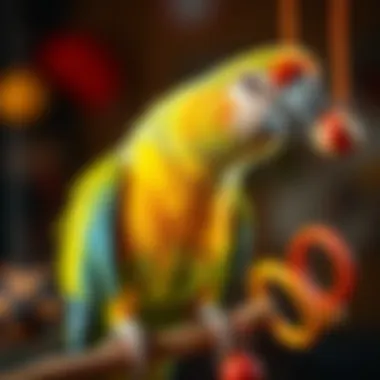
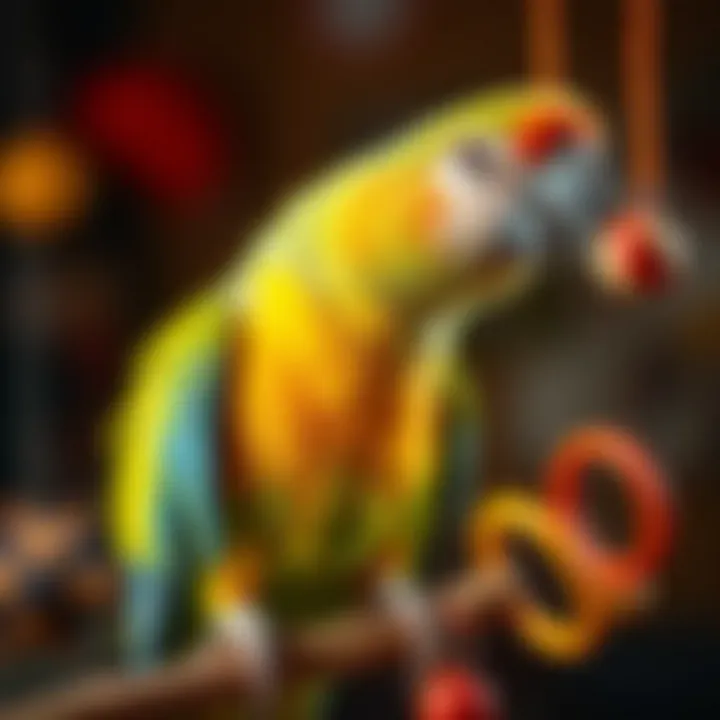
Choosing the right toys not only plays a role in your parrot's happiness but also provides a dynamic environment that nurtures their intellect and physical health.
In short, each type of bird toy encompasses unique benefits and serves distinct purposes. By actively selecting toys that cater to chewing, foraging, physical activity, and social interaction, you’re setting your parrot up for a lifetime of enriched experiences.
Choosing the Right Toys for Your Parrot
Selecting the right toys for your parrot is not just about convenience; it’s about enriching their daily life. Parrots are lively creatures, requiring mental stimulation and physical activity. Toys play a crucial role in this aspect of their behavior. They can help alleviate boredom, reduce stress, and even prevent behavioral issues that stem from inactivity and lack of interaction. Choosing the right toys ensures that your feathered friend thrives in its environment, maintaining both physical and emotional well-being.
Assessing Parrot Preferences
Every parrot has distinct likes and dislikes, which can vary significantly from one bird to another. Assessing these preferences is the first step towards selecting effective toys. Here are a few ways to understand your parrot better:
- Observation: Watch how your parrot interacts with its surroundings. Is it more inclined to chew, climb, or forage? Taking note of these actions can help guide your toy selection.
- Experimentation: Introduce a variety of toys made from different materials and textures. You might find that your parrot prefers wooden toys over plastic, or that it enjoys rope toys more than bells.
- Feedback: Parrots can be quite vocal about their likes or dislikes. If your bird seems uninterested in a toy, it’s a good indicator that it might not be the right fit.
Keeping a close eye on what excites or engages your parrot can lead you to make informed choices in the long run.
Considerations for Size and Material
When selecting toys, size and material are paramount concerns. Choosing the wrong size or unsuitable materials can lead to discomfort or, even worse, injury. Here are some factors to consider:
- Size: Toys should fit comfortably in the bird’s beak and be easy for it to handle. If a toy is too small, it could pose a choking hazard. Conversely, a toy that’s too large may not be accessible or engaging. As a general guide, consider the size of your parrot species; for instance, a macaw will require larger toys than a budgie.
- Material: The material of the toy can influence its safety and durability. Opt for non-toxic materials such as untreated wood, natural fibers, and safe plastics. Avoid toys made from painted wood, as the paint can be harmful if swallowed. Do check for visible signs of wear and tear, especially if your parrot is a chewer. Regular inspections can also keep your bird safe.
Ultimately, understanding these nuances sets the stage for your parrot’s happiness and safety.
"Investing time in choosing the right toys is investing in your parrot's happiness; they're not just playthings, they're essential for their well-being."
For more ideas on enriching your parrot’s habitat, you can visit Birds and Blooms or check out resources on Parrots Daily.
Safety Considerations in Bird Toys
When it comes to the well-being of parrots, ensuring the safety of toys is of utmost importance. Parrots are curious creatures and, unfortunately, their inclination to chew, explore, and investigate can put them at risk if the toys they play with are made from unsafe materials or are poorly designed. As a pet owner, it is crucial to thoroughly assess each toy before introducing them into your feathered friend’s environment.
One significant aspect of toy safety involves selecting those made from non-toxic materials. Often, pet owners overlook this part, thinking that plastic or wood is simply safe enough. However, many materials can be harmful. The implications of using unsafe toys can range from discomfort or minor injuries to severe health issues that can jeopardize a parrot’s life. Hence, understanding what materials are safe can be life-saving.
Identifying Unsafe Materials
Bird toys might seem innocent at first glance, but several materials can be hazardous. Common unsafe materials include:
- Treated woods: Woods that are chemically treated can contain harmful toxins. Always choose natural, untreated wood, such as pine or bamboo.
- Paints and dyes: Vibrant colors can be enticing, but many paints are laden with lead and other toxins which can leach onto your parrot’s beak as they chew.
- Plastic: Some plastics can break and create sharp edges, while others may not stand up to chewing, leading to ingestion.
- Metal alloys: Toys made with unknown metals may rust or have coatings that can be poisonous.
To minimize risks, opt for toys from reputable manufacturers that specifically cater to birds. Check labels and seek clarity about the materials used. If unsure, a quick online search can often reveal safety information about specific products. Seeking community advice from platforms like Reddit can also be beneficial.
Regular Maintenance and Inspection
Toys aren’t just a one-time purchase but rather require ongoing attention. Just like a car, they need regular maintenance to ensure they are in safe working order. Routine inspection is key in identifying any wear and tear that can pose risks to your bird. Regularly check toys for signs of:
- Chewing wear: If you notice that parts of the toy are frayed or missing, it may not be safe for your parrot to continue using.
- Damage: Broken pieces can create choking hazards and sharp edges that could injure your bird.
- Loss of interest: If your parrot is no longer engaging with a toy, that could be a signal it’s broken or no longer appealing, potentially indicating an area that needs replacement or cleaning.
It’s advisable to set a schedule to inspect toys weekly. Furthermore, consider giving each toy a good cleaning. A gentle wash with warm soapy water can keep your parrot’s environment sanitary and reduce the risk of infections or illnesses.
"A safe toy is one of the greatest gifts a parrot owner can give to their feathered companion."
To sum up, bird toys can greatly enhance a parrot's quality of life, but without appropriate safety measures and routine maintenance, they can also lead to unfortunate outcomes. As a responsible pet owner, taking the time to identify unsafe materials and commit to regular toy maintenance ensures that your feathered friends thrive in a secure and healthy play environment.
Behavioral Insights
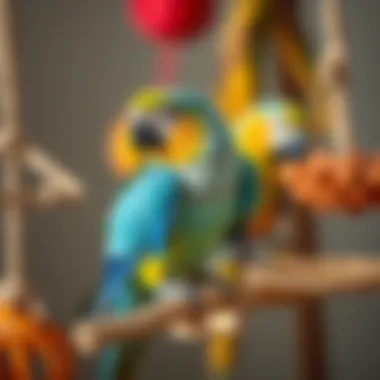

Understanding the behavior of parrots, particularly how toys can impact their mood and overall well-being, is crucial for any bird owner. Parrots are intelligent creatures, known for their vivid personalities and social nature. Without proper stimulation, they can easily become bored, leading to various behavioral issues. This section delves into the way toys play a fundamental role in enhancing their emotional health.
How Toys Affect Behavior and Mood
Toys are more than just playthings for parrots; they are gateways to mental engagement and emotional expression. When birds interact with toys, they display behaviors that are often tied to their emotional state. For instance, a parrot that shows interest in a chew toy is likely to experience a release of pent-up energy and stress. This interaction helps them feel fulfilled, which can decrease aggressive tendencies, feather plucking, and other stress-related behaviors.
In particular, interactive toys provide opportunities for social interaction, simulating the natural foraging and problem-solving behaviors parrots would encounter in the wild. For example, a puzzle that rewards a bird with a treat can trigger its natural curiosity and investigative instincts. This not only aids in their cognitive development but contributes to a happier mood.
"Providing the right toys can transform a parrot's emotional landscape, shifting it from one of potential distress to one of playful exploration."
Regular engagement with toys can also serve as a stress reliever. When parrots have access to a variety of toys that they can explore at their own pace, they tend to exhibit less anxiety and feel more secure in their environment. This encourages them to vocalize and act more freely, indicating a positive state of mind.
Creating a Balanced Play Environment
The impact of toys on a parrot's behavior extends beyond the toys themselves; it hinges on how these toys fit into a broader play environment. Creating a balanced and enriching space revolves around a few key elements:
- Variety of Toys: Rotate toys regularly to maintain interest. Having different textures, colors, and sounds can pique a parrot’s curiosity and encourage exploration.
- Safe Space: Ensure that the play area is comfortable and secure. Parrots need to feel safe while they navigate their environment, and the presence of harmful objects can make them anxious.
- Social Interaction: As social birds, parrots thrive on interaction with both their human caregivers and other birds. Including toys that foster social play can promote bonding and reduce loneliness.
- Physical Activity: Include climbing structures and swings as part of the play setup, allowing parrots to engage in physical exercise while exploring.
- Problem-Solving Opportunities: Employ foraging toys that challenge the bird, requiring them to think and work for their rewards. This not only serves their instinctual needs but can enhance their cognitive function as well.
Incorporating these elements into a parrot's play area not only addresses their physical needs but also nurtures their psychological welfare. As a result, a vibrant play environment transforms the daily life of these birds, offering them the chance to thrive and flourish.
Building a Toy Rotation System
Creating a toy rotation system is a smart move for parrot owners aiming to enhance their feathered friend's overall well-being. Parrots, with their keen intelligence and lively personalities, require mental stimulation and physical engagement. Rotating toys is not just a method of play—it's a way to spark curiosity and maintain freshness in their environment. It ensures that toys don’t become mundane and lose their appeal over time.
When toys stay the same for too long, a parrot might quickly lose interest. Just like humans, birds thrive on novelty. A rotation system invites new challenges and experiences, leading to a happier and more engaged parrot. It’s a simple yet effective tactic that can bridge the gap between boredom and playfulness in your bird’s life.
Benefits of Rotating Toys
Switching up toys regularly has several advantages for both the parrot and the owner. Here are some key benefits:
- Prevention of Boredom: Constant exposure to the same toys can result in stagnation. By rotating toys, parrots are delivered fresh stimuli, keeping their interest piqued.
- Enhanced Problem Solving: Different toys encourage new ways of interaction, be it chewing, climbing, or foraging. This variety can help develop problem-solving skills.
- Physical Health: Utilizing a range of toys often requires movement, which is essential for maintaining a healthy weight and overall fitness.
- Behavioral Stability: Rotating toys can minimize behavioral issues that arise from boredom, like excessive screaming or feather-plucking.
- Mental Stimulation: Novel experiences help keep a parrot's mind sharp, ensuring they remain mentally healthy and engaged.
"Birds are more than mere pets; they are companions that flourish in enriched environments."
Implementing Effective Rotation Strategies
To successfully implement a toy rotation system, it's essential to consider several strategies tailored to the unique needs of your parrot. Here are some methods to ensure its effectiveness:
- Monthly Schedule: Create a rotating schedule where you introduce new toys monthly, swapping them with old ones. This way, excitement is preserved, and parrots don't have the chance to get bored.
- Observation: Watch how your parrot interacts with each toy. Take note of their favorites but also ensure they try out a variety of toys. This will give you insight into what types of toys to prioritize in future rotations.
- Themed Rotations: You can create themed rotations based on skill improvement, like focusing on foraging one month, climbing the next, etc. This approach can provide a more structured challenge for your parrot.
- Toys to Trial: Introduce new toys occasionally but still have a core group that they recognize and feel comfortable with. This balance keeps things exciting without overwhelming them.
- Safe Storage: Keep unused toys stored safely, out of the parrot’s reach. When they return to a toy, it may feel like new again, providing added excitement.
Using these strategies allows the process of rotation to flow smoothly while benefiting your parrot’s emotional and mental health.
The End
As we wrap up our exploration into the significant role of toys in parrot well-being, it becomes clear that these seemingly simple objects hold great influence over the lives of our feathered companions. The importance of selecting appropriate and engaging toys cannot be overstated. Not only do they stimulate a parrot's mental faculties, but they also contribute vastly to their physical health and overall happiness. By providing a variety of toy types that cater to instinctual behaviors—such as chewing, foraging, and climbing—owners set the stage for enriched lives and well-adjusted birds.
Recap of Key Points
In reconsidering the insights shared throughout this article, several key points stand out:
- Enrichment is Essential: Parrots, being intelligent creatures, require regular mental stimulation through toys to avoid boredom and the development of destructive behaviors.
- Variety is the Spice of Life: From chew toys that promote beak health to interactive toys enhancing social interaction, having a range of options keeps parrots engaged.
- Safety Matters: Ensuring that toys are constructed from safe, non-toxic materials is crucial to prevent any health hazards.
- Behavioral Impacts: The right toys can have an immense impact on a parrot's mood and even their social dynamics, demonstrating the need for thoughtful integration into their environment.
- Toy Rotation: Regularly changing the toys not only keeps the parrot interested but also promotes continued engagement and exploration of their environment.
Future Directions in Parrot Care
Looking ahead, it is worth considering how our understanding of parrot care will evolve as research in animal behavior progresses. Future directions in parrot enrichment will likely include:
- Personalized Toy Experiences: Just as pet owners increasingly tailor diets to the specific needs of their animals, a deeper understanding of individual parrot preferences may lead to more customized play experiences, ensuring each parrot receives stimulation that suits their unique personality.
- Use of Technology: With advances in technology, we may soon see interactive toys that respond to bird actions, further enriching the play experience and promoting cognitive engagement.
With persistence and careful attention, parrot owners can harness the power of play to foster profound emotional well-being in their pets.
- Integration of Social Behaviors: The inclusion of toys that promote social play, whether between parrots or with humans, will likely gain more focus as we understand the social dynamics within parrot communities.
Through ongoing research and a commitment to understanding the nuanced needs of these birds, the future of parrot care is poised to become more informed and thoughtful, ultimately leading to happier, healthier birds.







